Financial Accounting Report: Stakeholders, Statements, and Entries
VerifiedAdded on 2021/02/20
|30
|4643
|34
Report
AI Summary
This financial accounting report provides a detailed analysis of the subject, starting with an introduction to the meaning and purpose of financial accounting (FA), along with a comparison between financial and management accounting. It identifies internal and external stakeholders and examines journal entries, trial balances, income statements, and balance sheets for different clients. The report also covers key accounting concepts like consistency and prudence, the purpose of depreciation, and differences between sole trader and limited company financial statements. Further topics include bank reconciliation statements, petty cash systems, sales and purchase ledgers, control accounts, suspense accounts, error rectification, and a final trial balance. The report concludes with a comprehensive overview of the subject matter, providing a thorough understanding of financial accounting principles and practices.

Financial Accounting
Paraphrase This Document
Need a fresh take? Get an instant paraphrase of this document with our AI Paraphraser
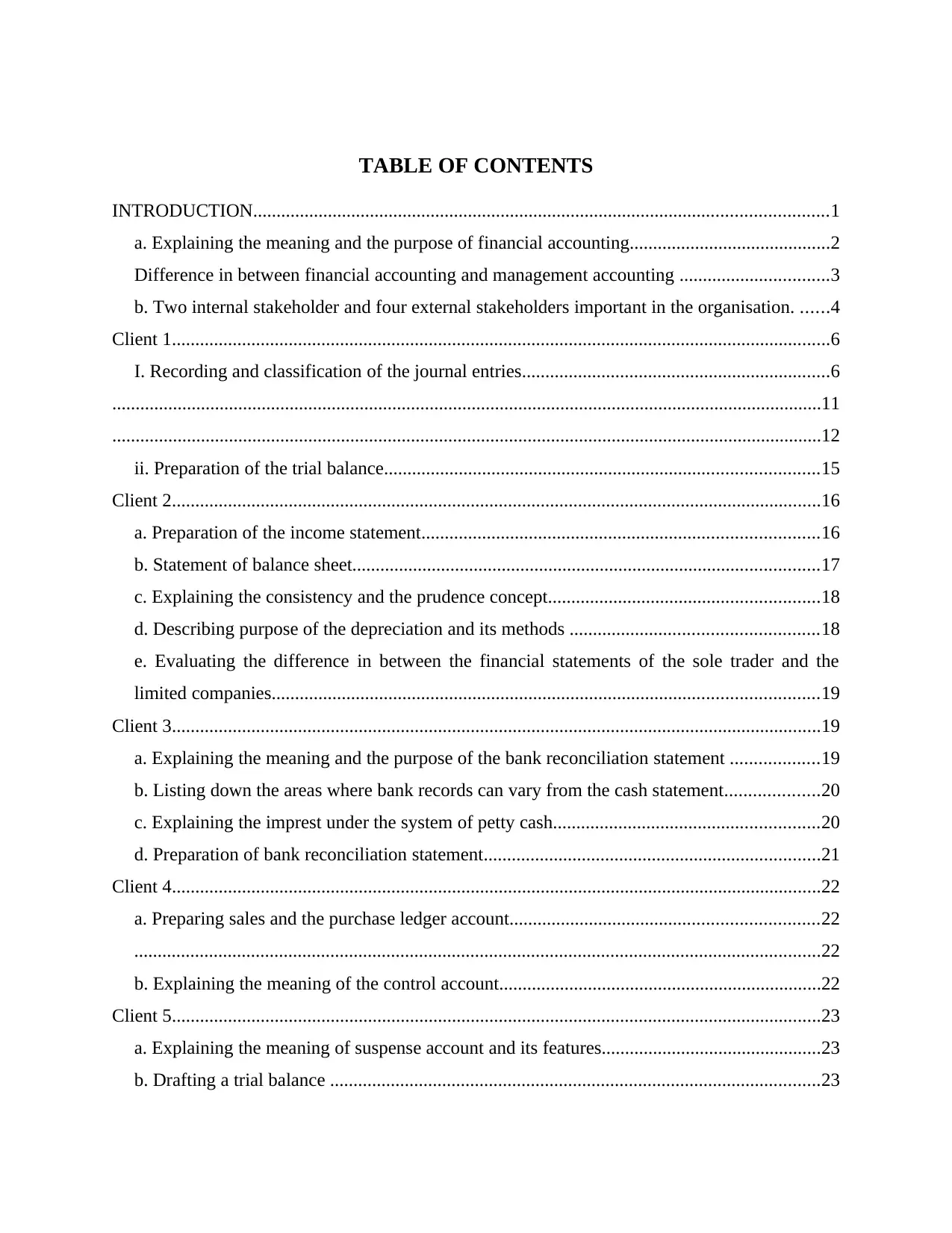
TABLE OF CONTENTS
INTRODUCTION...........................................................................................................................1
a. Explaining the meaning and the purpose of financial accounting...........................................2
Difference in between financial accounting and management accounting ................................3
b. Two internal stakeholder and four external stakeholders important in the organisation. ......4
Client 1.............................................................................................................................................6
I. Recording and classification of the journal entries..................................................................6
........................................................................................................................................................11
........................................................................................................................................................12
ii. Preparation of the trial balance.............................................................................................15
Client 2...........................................................................................................................................16
a. Preparation of the income statement.....................................................................................16
b. Statement of balance sheet....................................................................................................17
c. Explaining the consistency and the prudence concept..........................................................18
d. Describing purpose of the depreciation and its methods .....................................................18
e. Evaluating the difference in between the financial statements of the sole trader and the
limited companies.....................................................................................................................19
Client 3...........................................................................................................................................19
a. Explaining the meaning and the purpose of the bank reconciliation statement ...................19
b. Listing down the areas where bank records can vary from the cash statement....................20
c. Explaining the imprest under the system of petty cash.........................................................20
d. Preparation of bank reconciliation statement........................................................................21
Client 4...........................................................................................................................................22
a. Preparing sales and the purchase ledger account..................................................................22
...................................................................................................................................................22
b. Explaining the meaning of the control account.....................................................................22
Client 5...........................................................................................................................................23
a. Explaining the meaning of suspense account and its features...............................................23
b. Drafting a trial balance .........................................................................................................23
INTRODUCTION...........................................................................................................................1
a. Explaining the meaning and the purpose of financial accounting...........................................2
Difference in between financial accounting and management accounting ................................3
b. Two internal stakeholder and four external stakeholders important in the organisation. ......4
Client 1.............................................................................................................................................6
I. Recording and classification of the journal entries..................................................................6
........................................................................................................................................................11
........................................................................................................................................................12
ii. Preparation of the trial balance.............................................................................................15
Client 2...........................................................................................................................................16
a. Preparation of the income statement.....................................................................................16
b. Statement of balance sheet....................................................................................................17
c. Explaining the consistency and the prudence concept..........................................................18
d. Describing purpose of the depreciation and its methods .....................................................18
e. Evaluating the difference in between the financial statements of the sole trader and the
limited companies.....................................................................................................................19
Client 3...........................................................................................................................................19
a. Explaining the meaning and the purpose of the bank reconciliation statement ...................19
b. Listing down the areas where bank records can vary from the cash statement....................20
c. Explaining the imprest under the system of petty cash.........................................................20
d. Preparation of bank reconciliation statement........................................................................21
Client 4...........................................................................................................................................22
a. Preparing sales and the purchase ledger account..................................................................22
...................................................................................................................................................22
b. Explaining the meaning of the control account.....................................................................22
Client 5...........................................................................................................................................23
a. Explaining the meaning of suspense account and its features...............................................23
b. Drafting a trial balance .........................................................................................................23

c. Rectification of errors ...........................................................................................................24
CONCLUSION..............................................................................................................................24
REFERENCES..............................................................................................................................25
CONCLUSION..............................................................................................................................24
REFERENCES..............................................................................................................................25
⊘ This is a preview!⊘
Do you want full access?
Subscribe today to unlock all pages.

Trusted by 1+ million students worldwide
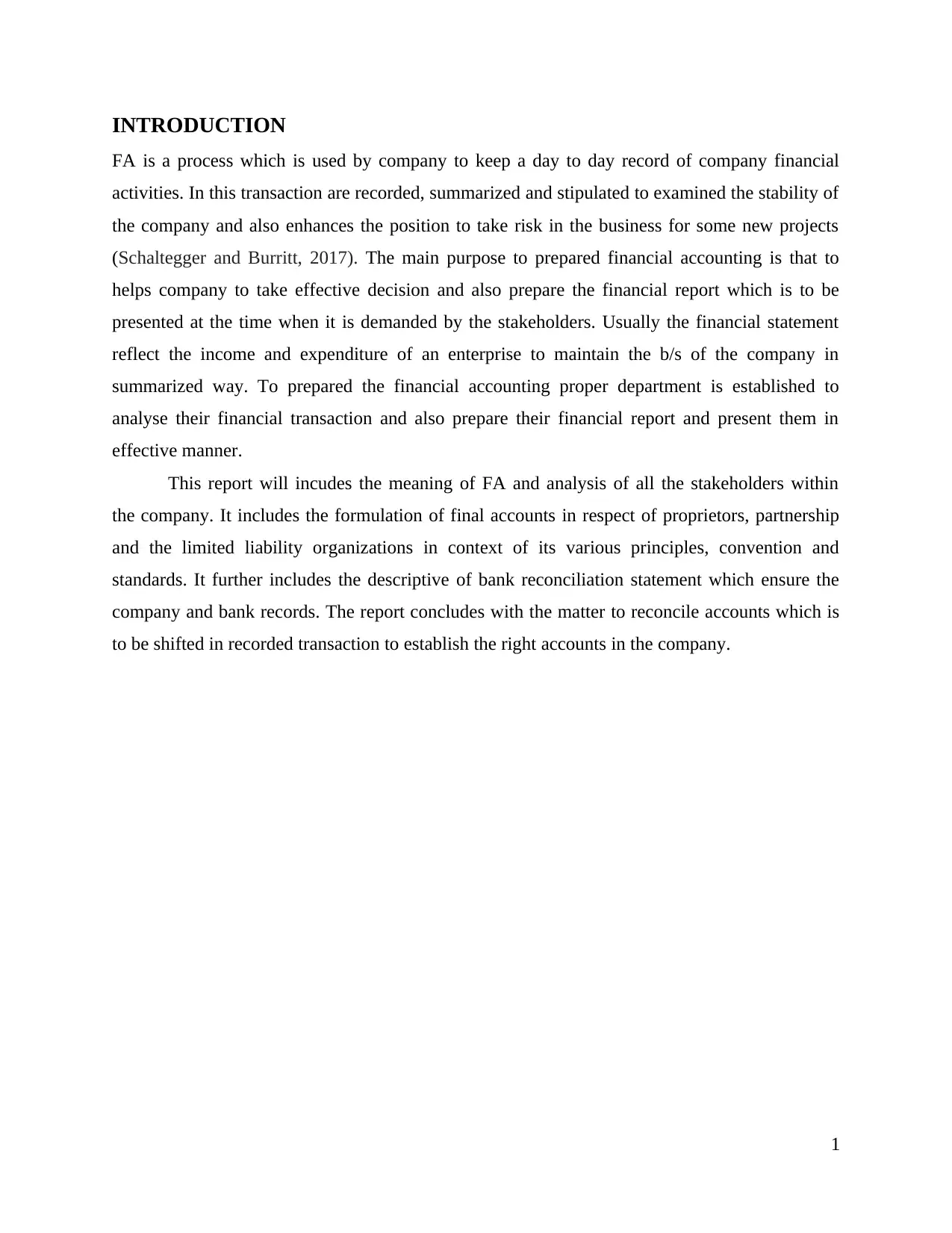
INTRODUCTION
FA is a process which is used by company to keep a day to day record of company financial
activities. In this transaction are recorded, summarized and stipulated to examined the stability of
the company and also enhances the position to take risk in the business for some new projects
(Schaltegger and Burritt, 2017). The main purpose to prepared financial accounting is that to
helps company to take effective decision and also prepare the financial report which is to be
presented at the time when it is demanded by the stakeholders. Usually the financial statement
reflect the income and expenditure of an enterprise to maintain the b/s of the company in
summarized way. To prepared the financial accounting proper department is established to
analyse their financial transaction and also prepare their financial report and present them in
effective manner.
This report will incudes the meaning of FA and analysis of all the stakeholders within
the company. It includes the formulation of final accounts in respect of proprietors, partnership
and the limited liability organizations in context of its various principles, convention and
standards. It further includes the descriptive of bank reconciliation statement which ensure the
company and bank records. The report concludes with the matter to reconcile accounts which is
to be shifted in recorded transaction to establish the right accounts in the company.
1
FA is a process which is used by company to keep a day to day record of company financial
activities. In this transaction are recorded, summarized and stipulated to examined the stability of
the company and also enhances the position to take risk in the business for some new projects
(Schaltegger and Burritt, 2017). The main purpose to prepared financial accounting is that to
helps company to take effective decision and also prepare the financial report which is to be
presented at the time when it is demanded by the stakeholders. Usually the financial statement
reflect the income and expenditure of an enterprise to maintain the b/s of the company in
summarized way. To prepared the financial accounting proper department is established to
analyse their financial transaction and also prepare their financial report and present them in
effective manner.
This report will incudes the meaning of FA and analysis of all the stakeholders within
the company. It includes the formulation of final accounts in respect of proprietors, partnership
and the limited liability organizations in context of its various principles, convention and
standards. It further includes the descriptive of bank reconciliation statement which ensure the
company and bank records. The report concludes with the matter to reconcile accounts which is
to be shifted in recorded transaction to establish the right accounts in the company.
1
Paraphrase This Document
Need a fresh take? Get an instant paraphrase of this document with our AI Paraphraser
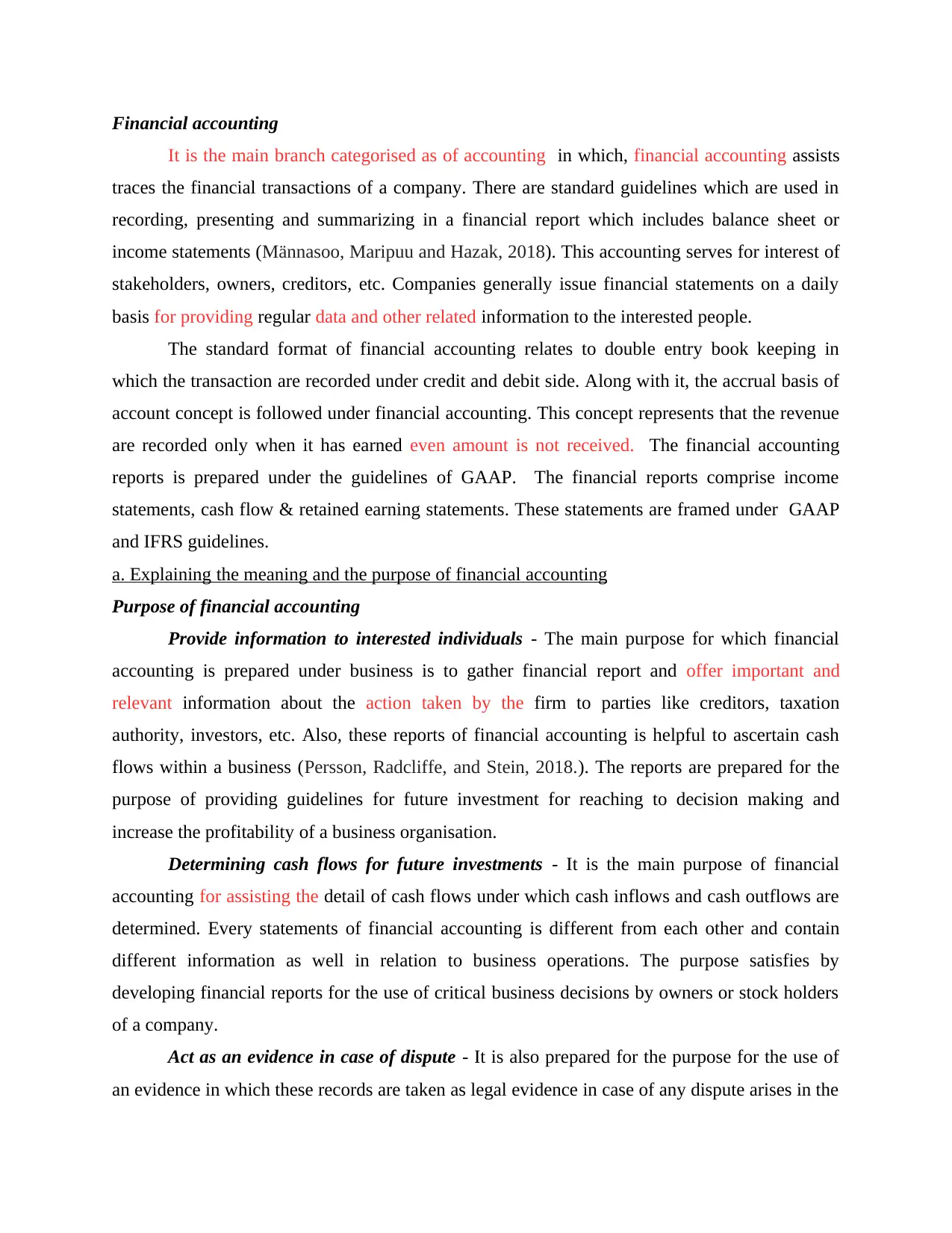
Financial accounting
It is the main branch categorised as of accounting in which, financial accounting assists
traces the financial transactions of a company. There are standard guidelines which are used in
recording, presenting and summarizing in a financial report which includes balance sheet or
income statements (Männasoo, Maripuu and Hazak, 2018). This accounting serves for interest of
stakeholders, owners, creditors, etc. Companies generally issue financial statements on a daily
basis for providing regular data and other related information to the interested people.
The standard format of financial accounting relates to double entry book keeping in
which the transaction are recorded under credit and debit side. Along with it, the accrual basis of
account concept is followed under financial accounting. This concept represents that the revenue
are recorded only when it has earned even amount is not received. The financial accounting
reports is prepared under the guidelines of GAAP. The financial reports comprise income
statements, cash flow & retained earning statements. These statements are framed under GAAP
and IFRS guidelines.
a. Explaining the meaning and the purpose of financial accounting
Purpose of financial accounting
Provide information to interested individuals - The main purpose for which financial
accounting is prepared under business is to gather financial report and offer important and
relevant information about the action taken by the firm to parties like creditors, taxation
authority, investors, etc. Also, these reports of financial accounting is helpful to ascertain cash
flows within a business (Persson, Radcliffe, and Stein, 2018.). The reports are prepared for the
purpose of providing guidelines for future investment for reaching to decision making and
increase the profitability of a business organisation.
Determining cash flows for future investments - It is the main purpose of financial
accounting for assisting the detail of cash flows under which cash inflows and cash outflows are
determined. Every statements of financial accounting is different from each other and contain
different information as well in relation to business operations. The purpose satisfies by
developing financial reports for the use of critical business decisions by owners or stock holders
of a company.
Act as an evidence in case of dispute - It is also prepared for the purpose for the use of
an evidence in which these records are taken as legal evidence in case of any dispute arises in the
It is the main branch categorised as of accounting in which, financial accounting assists
traces the financial transactions of a company. There are standard guidelines which are used in
recording, presenting and summarizing in a financial report which includes balance sheet or
income statements (Männasoo, Maripuu and Hazak, 2018). This accounting serves for interest of
stakeholders, owners, creditors, etc. Companies generally issue financial statements on a daily
basis for providing regular data and other related information to the interested people.
The standard format of financial accounting relates to double entry book keeping in
which the transaction are recorded under credit and debit side. Along with it, the accrual basis of
account concept is followed under financial accounting. This concept represents that the revenue
are recorded only when it has earned even amount is not received. The financial accounting
reports is prepared under the guidelines of GAAP. The financial reports comprise income
statements, cash flow & retained earning statements. These statements are framed under GAAP
and IFRS guidelines.
a. Explaining the meaning and the purpose of financial accounting
Purpose of financial accounting
Provide information to interested individuals - The main purpose for which financial
accounting is prepared under business is to gather financial report and offer important and
relevant information about the action taken by the firm to parties like creditors, taxation
authority, investors, etc. Also, these reports of financial accounting is helpful to ascertain cash
flows within a business (Persson, Radcliffe, and Stein, 2018.). The reports are prepared for the
purpose of providing guidelines for future investment for reaching to decision making and
increase the profitability of a business organisation.
Determining cash flows for future investments - It is the main purpose of financial
accounting for assisting the detail of cash flows under which cash inflows and cash outflows are
determined. Every statements of financial accounting is different from each other and contain
different information as well in relation to business operations. The purpose satisfies by
developing financial reports for the use of critical business decisions by owners or stock holders
of a company.
Act as an evidence in case of dispute - It is also prepared for the purpose for the use of
an evidence in which these records are taken as legal evidence in case of any dispute arises in the
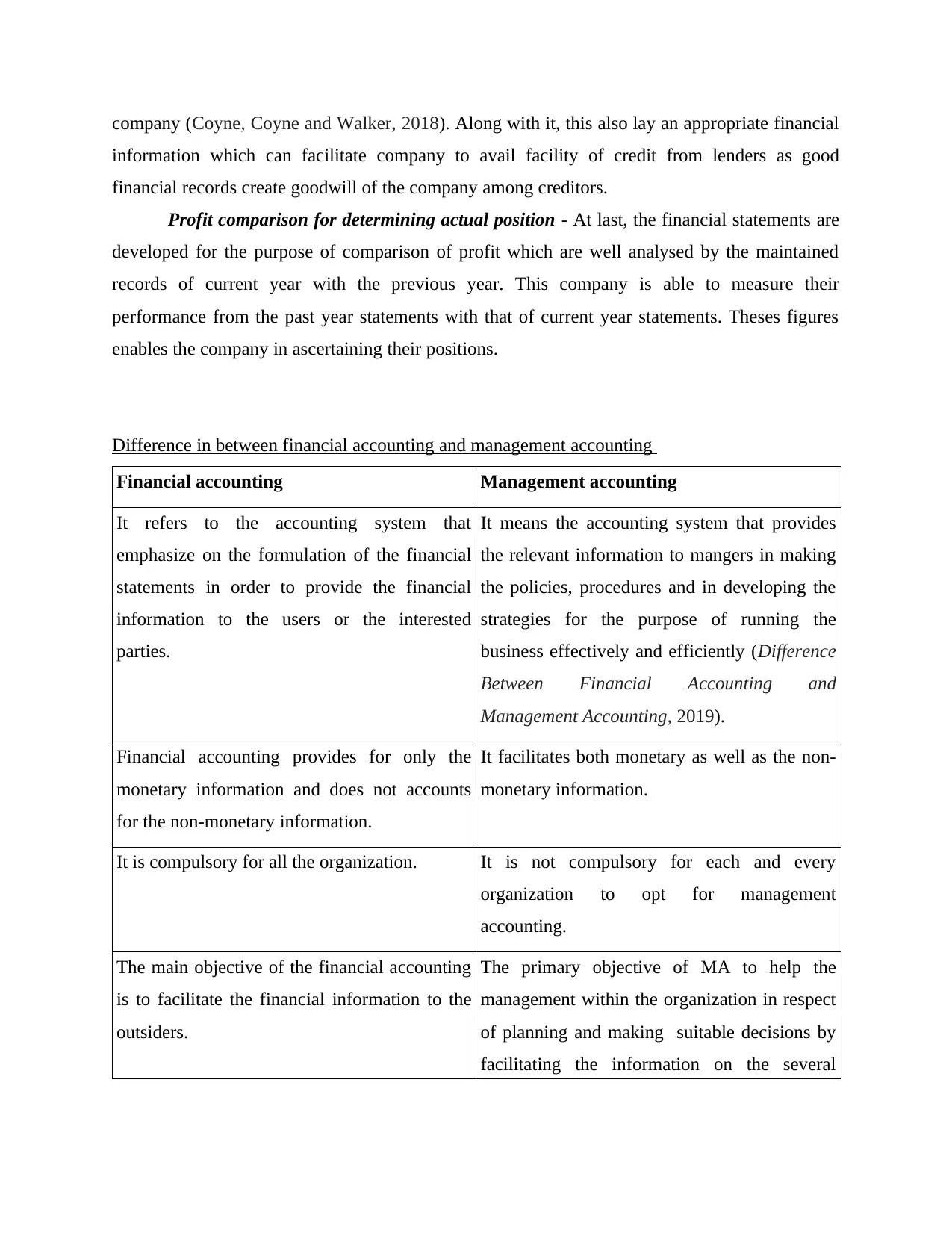
company (Coyne, Coyne and Walker, 2018). Along with it, this also lay an appropriate financial
information which can facilitate company to avail facility of credit from lenders as good
financial records create goodwill of the company among creditors.
Profit comparison for determining actual position - At last, the financial statements are
developed for the purpose of comparison of profit which are well analysed by the maintained
records of current year with the previous year. This company is able to measure their
performance from the past year statements with that of current year statements. Theses figures
enables the company in ascertaining their positions.
Difference in between financial accounting and management accounting
Financial accounting Management accounting
It refers to the accounting system that
emphasize on the formulation of the financial
statements in order to provide the financial
information to the users or the interested
parties.
It means the accounting system that provides
the relevant information to mangers in making
the policies, procedures and in developing the
strategies for the purpose of running the
business effectively and efficiently (Difference
Between Financial Accounting and
Management Accounting, 2019).
Financial accounting provides for only the
monetary information and does not accounts
for the non-monetary information.
It facilitates both monetary as well as the non-
monetary information.
It is compulsory for all the organization. It is not compulsory for each and every
organization to opt for management
accounting.
The main objective of the financial accounting
is to facilitate the financial information to the
outsiders.
The primary objective of MA to help the
management within the organization in respect
of planning and making suitable decisions by
facilitating the information on the several
information which can facilitate company to avail facility of credit from lenders as good
financial records create goodwill of the company among creditors.
Profit comparison for determining actual position - At last, the financial statements are
developed for the purpose of comparison of profit which are well analysed by the maintained
records of current year with the previous year. This company is able to measure their
performance from the past year statements with that of current year statements. Theses figures
enables the company in ascertaining their positions.
Difference in between financial accounting and management accounting
Financial accounting Management accounting
It refers to the accounting system that
emphasize on the formulation of the financial
statements in order to provide the financial
information to the users or the interested
parties.
It means the accounting system that provides
the relevant information to mangers in making
the policies, procedures and in developing the
strategies for the purpose of running the
business effectively and efficiently (Difference
Between Financial Accounting and
Management Accounting, 2019).
Financial accounting provides for only the
monetary information and does not accounts
for the non-monetary information.
It facilitates both monetary as well as the non-
monetary information.
It is compulsory for all the organization. It is not compulsory for each and every
organization to opt for management
accounting.
The main objective of the financial accounting
is to facilitate the financial information to the
outsiders.
The primary objective of MA to help the
management within the organization in respect
of planning and making suitable decisions by
facilitating the information on the several
⊘ This is a preview!⊘
Do you want full access?
Subscribe today to unlock all pages.

Trusted by 1+ million students worldwide
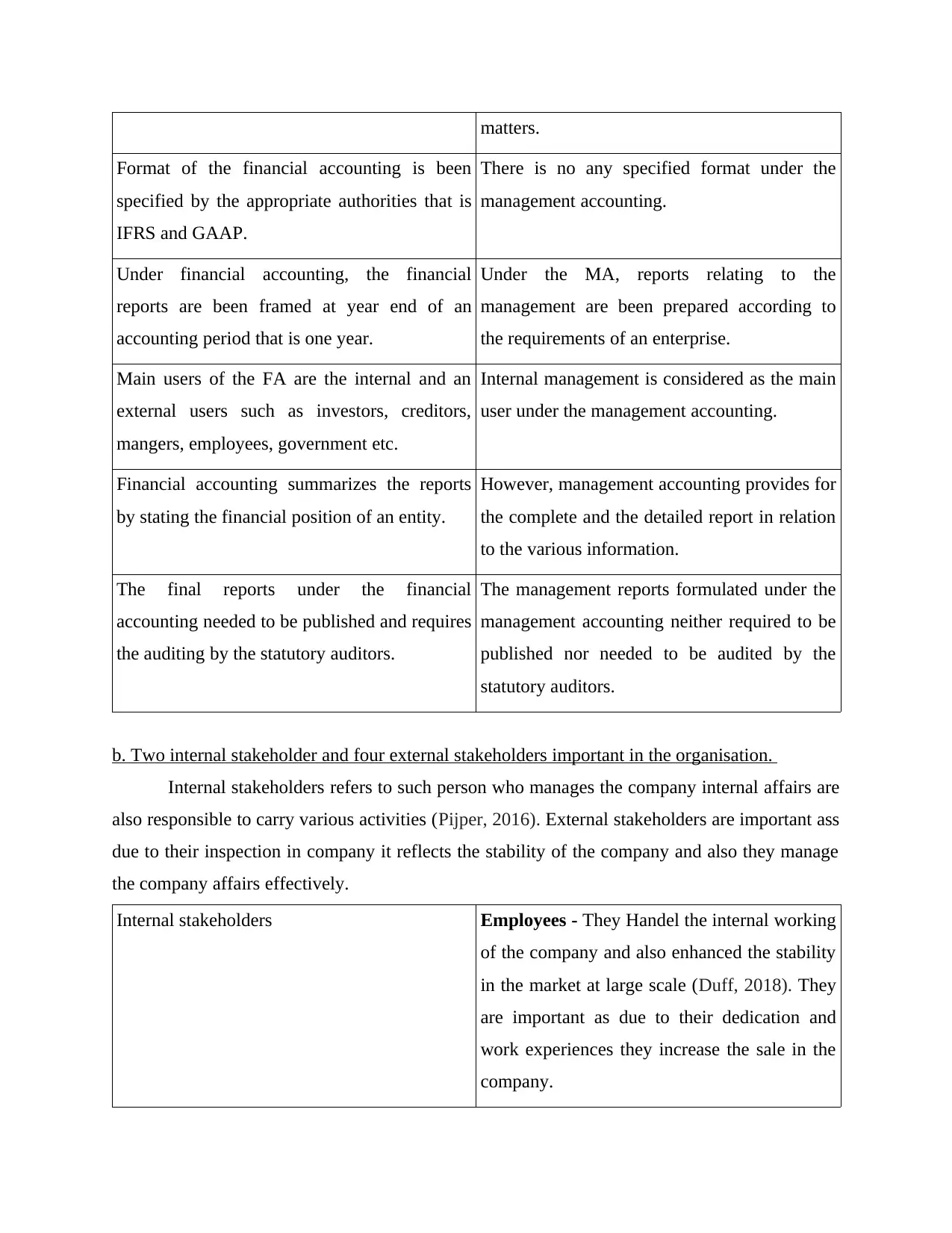
matters.
Format of the financial accounting is been
specified by the appropriate authorities that is
IFRS and GAAP.
There is no any specified format under the
management accounting.
Under financial accounting, the financial
reports are been framed at year end of an
accounting period that is one year.
Under the MA, reports relating to the
management are been prepared according to
the requirements of an enterprise.
Main users of the FA are the internal and an
external users such as investors, creditors,
mangers, employees, government etc.
Internal management is considered as the main
user under the management accounting.
Financial accounting summarizes the reports
by stating the financial position of an entity.
However, management accounting provides for
the complete and the detailed report in relation
to the various information.
The final reports under the financial
accounting needed to be published and requires
the auditing by the statutory auditors.
The management reports formulated under the
management accounting neither required to be
published nor needed to be audited by the
statutory auditors.
b. Two internal stakeholder and four external stakeholders important in the organisation.
Internal stakeholders refers to such person who manages the company internal affairs are
also responsible to carry various activities (Pijper, 2016). External stakeholders are important ass
due to their inspection in company it reflects the stability of the company and also they manage
the company affairs effectively.
Internal stakeholders Employees - They Handel the internal working
of the company and also enhanced the stability
in the market at large scale (Duff, 2018). They
are important as due to their dedication and
work experiences they increase the sale in the
company.
Format of the financial accounting is been
specified by the appropriate authorities that is
IFRS and GAAP.
There is no any specified format under the
management accounting.
Under financial accounting, the financial
reports are been framed at year end of an
accounting period that is one year.
Under the MA, reports relating to the
management are been prepared according to
the requirements of an enterprise.
Main users of the FA are the internal and an
external users such as investors, creditors,
mangers, employees, government etc.
Internal management is considered as the main
user under the management accounting.
Financial accounting summarizes the reports
by stating the financial position of an entity.
However, management accounting provides for
the complete and the detailed report in relation
to the various information.
The final reports under the financial
accounting needed to be published and requires
the auditing by the statutory auditors.
The management reports formulated under the
management accounting neither required to be
published nor needed to be audited by the
statutory auditors.
b. Two internal stakeholder and four external stakeholders important in the organisation.
Internal stakeholders refers to such person who manages the company internal affairs are
also responsible to carry various activities (Pijper, 2016). External stakeholders are important ass
due to their inspection in company it reflects the stability of the company and also they manage
the company affairs effectively.
Internal stakeholders Employees - They Handel the internal working
of the company and also enhanced the stability
in the market at large scale (Duff, 2018). They
are important as due to their dedication and
work experiences they increase the sale in the
company.
Paraphrase This Document
Need a fresh take? Get an instant paraphrase of this document with our AI Paraphraser

Managers – They are the persons who
manages the overall activity of an entity and
also handle employees and assigned them day
to day actively which is to be completed within
the stipulated time. The manager's role are
important in internal management of the
company.
External stakeholders Consumers- They purchase goods from the
company. Thus, if the company position is
stable, they can attract more consumers
towards their business (Clatworthy and Peel,
2016).
Investors - They are also major stakeholders in
the company as they invest money in the
project to get good return. They can also verify
build trust in the company and can also
demand their financial report. So to maintain
the reputation in the market company had to
present the appropriate report so that there is
continuous cash flow in the company.
Government - Government imposed taxes to
company regarding their transaction and also
their dealing in goods from import to export
(Ullah and et.al., 2018). Thus, government also
sometimes invests money in the company and
they can examine the financial report of the
company at any time. Thus, it is the duty of the
company to keep an up-to-date report so that it
can be presentable at any time.
Supplier - these are those persons who
manages the overall activity of an entity and
also handle employees and assigned them day
to day actively which is to be completed within
the stipulated time. The manager's role are
important in internal management of the
company.
External stakeholders Consumers- They purchase goods from the
company. Thus, if the company position is
stable, they can attract more consumers
towards their business (Clatworthy and Peel,
2016).
Investors - They are also major stakeholders in
the company as they invest money in the
project to get good return. They can also verify
build trust in the company and can also
demand their financial report. So to maintain
the reputation in the market company had to
present the appropriate report so that there is
continuous cash flow in the company.
Government - Government imposed taxes to
company regarding their transaction and also
their dealing in goods from import to export
(Ullah and et.al., 2018). Thus, government also
sometimes invests money in the company and
they can examine the financial report of the
company at any time. Thus, it is the duty of the
company to keep an up-to-date report so that it
can be presentable at any time.
Supplier - these are those persons who

supplies goods to the company and also they
are important. As company manage their
transaction by viewing the supply of raw
material and resources in the company. Thus,
supplier provides finished goods to company at
bargain rates if company had good terms with
them (Weetman, 2019).
Client 1
I. Recording of the journal entries
Journal entries in the books of Alexandra for January 2019 are as follows
Date particulars Debit Credit
1st jan 2019 Storage exp.A/c Dr 450
To bank A/c
2nd jan 2019 Purchase A/c Dr 6080
To S. hood A/c 1450
To D main A/c 2060
To W Tone A/c 960
To R foot A/c 1610
3rd jan 2019 J Wilson A/c Dr 1200
T . Cole A/c dr 1650
F. Syme A/c Dr 2100
J . Allen A/c Dr 1020
P. white A/c Dr F. Lane A/c Dr 2520
F. lane A/c Dr 980
To sales A/c 9470
4th jan 2019 Motor Exp. A/c Dr 470
are important. As company manage their
transaction by viewing the supply of raw
material and resources in the company. Thus,
supplier provides finished goods to company at
bargain rates if company had good terms with
them (Weetman, 2019).
Client 1
I. Recording of the journal entries
Journal entries in the books of Alexandra for January 2019 are as follows
Date particulars Debit Credit
1st jan 2019 Storage exp.A/c Dr 450
To bank A/c
2nd jan 2019 Purchase A/c Dr 6080
To S. hood A/c 1450
To D main A/c 2060
To W Tone A/c 960
To R foot A/c 1610
3rd jan 2019 J Wilson A/c Dr 1200
T . Cole A/c dr 1650
F. Syme A/c Dr 2100
J . Allen A/c Dr 1020
P. white A/c Dr F. Lane A/c Dr 2520
F. lane A/c Dr 980
To sales A/c 9470
4th jan 2019 Motor Exp. A/c Dr 470
⊘ This is a preview!⊘
Do you want full access?
Subscribe today to unlock all pages.

Trusted by 1+ million students worldwide
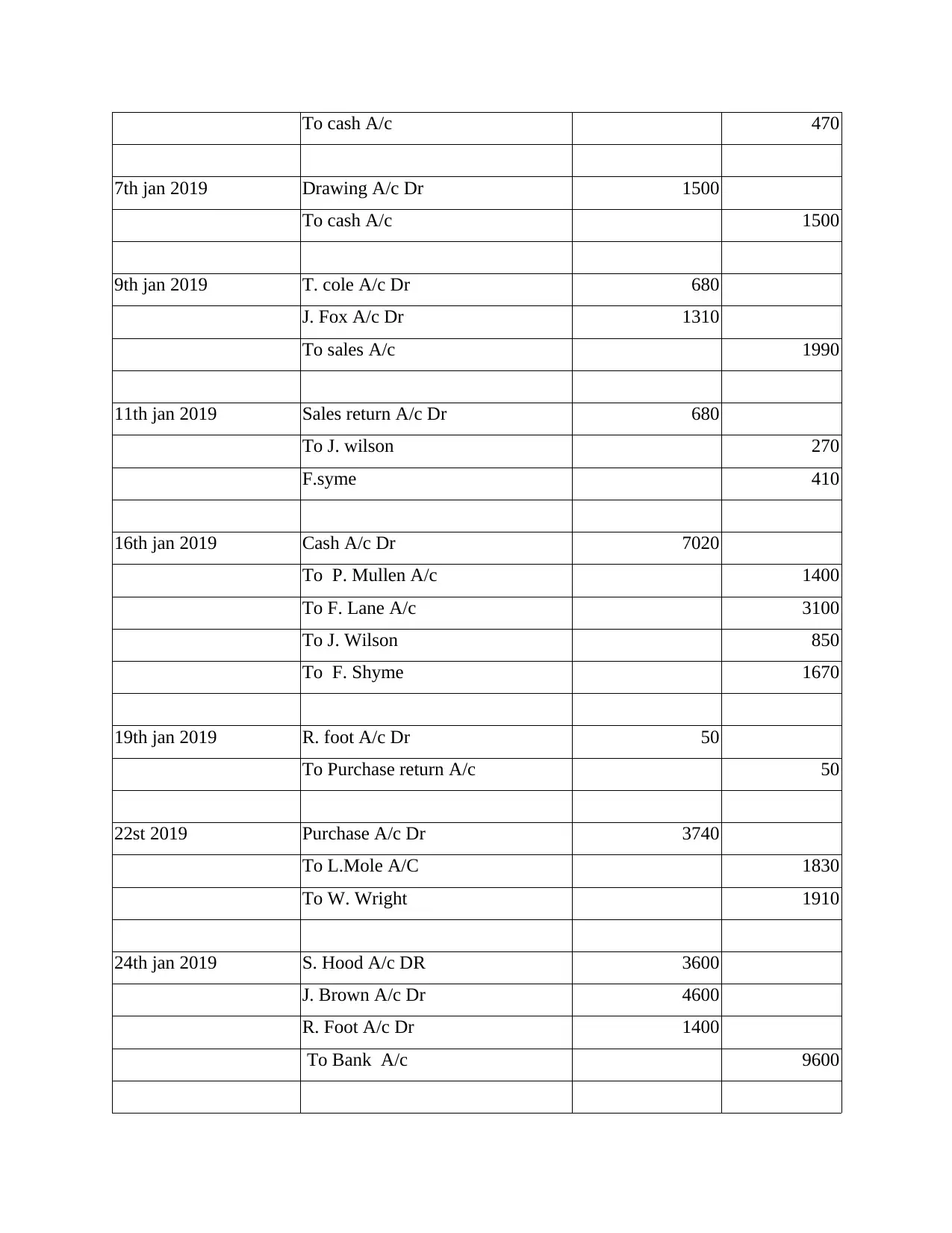
To cash A/c 470
7th jan 2019 Drawing A/c Dr 1500
To cash A/c 1500
9th jan 2019 T. cole A/c Dr 680
J. Fox A/c Dr 1310
To sales A/c 1990
11th jan 2019 Sales return A/c Dr 680
To J. wilson 270
F.syme 410
16th jan 2019 Cash A/c Dr 7020
To P. Mullen A/c 1400
To F. Lane A/c 3100
To J. Wilson 850
To F. Shyme 1670
19th jan 2019 R. foot A/c Dr 50
To Purchase return A/c 50
22st 2019 Purchase A/c Dr 3740
To L.Mole A/C 1830
To W. Wright 1910
24th jan 2019 S. Hood A/c DR 3600
J. Brown A/c Dr 4600
R. Foot A/c Dr 1400
To Bank A/c 9600
7th jan 2019 Drawing A/c Dr 1500
To cash A/c 1500
9th jan 2019 T. cole A/c Dr 680
J. Fox A/c Dr 1310
To sales A/c 1990
11th jan 2019 Sales return A/c Dr 680
To J. wilson 270
F.syme 410
16th jan 2019 Cash A/c Dr 7020
To P. Mullen A/c 1400
To F. Lane A/c 3100
To J. Wilson 850
To F. Shyme 1670
19th jan 2019 R. foot A/c Dr 50
To Purchase return A/c 50
22st 2019 Purchase A/c Dr 3740
To L.Mole A/C 1830
To W. Wright 1910
24th jan 2019 S. Hood A/c DR 3600
J. Brown A/c Dr 4600
R. Foot A/c Dr 1400
To Bank A/c 9600
Paraphrase This Document
Need a fresh take? Get an instant paraphrase of this document with our AI Paraphraser
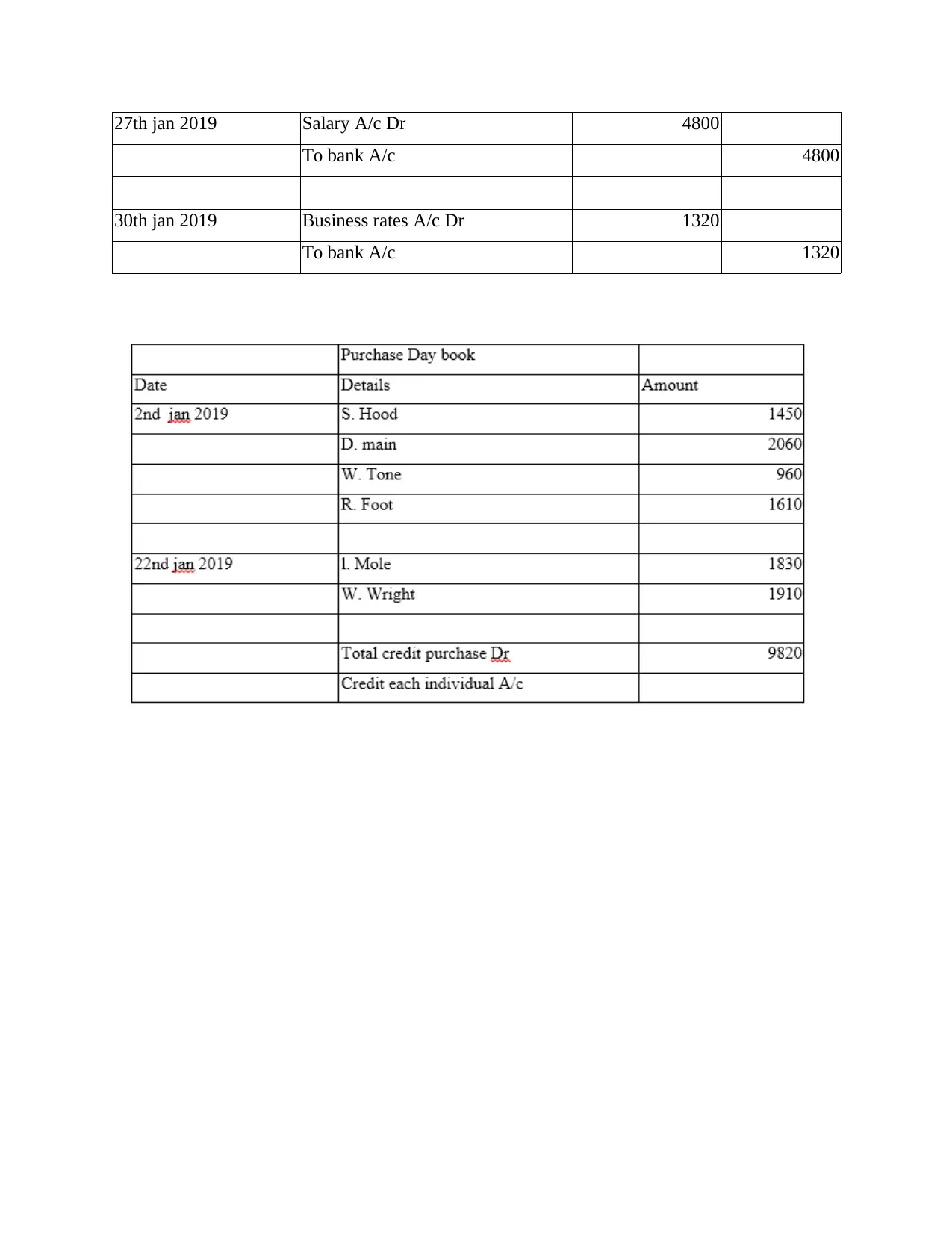
27th jan 2019 Salary A/c Dr 4800
To bank A/c 4800
30th jan 2019 Business rates A/c Dr 1320
To bank A/c 1320
To bank A/c 4800
30th jan 2019 Business rates A/c Dr 1320
To bank A/c 1320
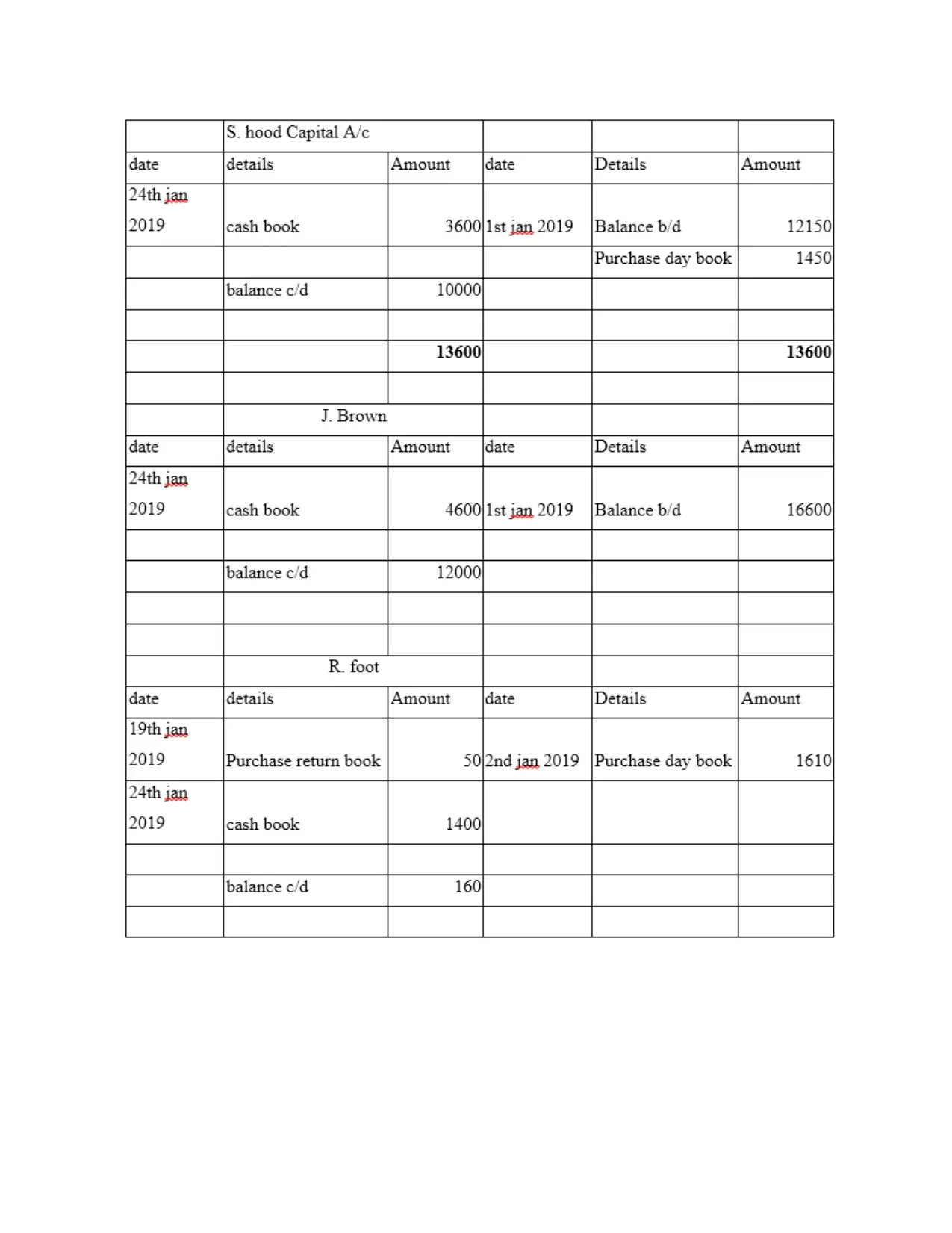
⊘ This is a preview!⊘
Do you want full access?
Subscribe today to unlock all pages.

Trusted by 1+ million students worldwide
1 out of 30
Related Documents
Your All-in-One AI-Powered Toolkit for Academic Success.
+13062052269
info@desklib.com
Available 24*7 on WhatsApp / Email
![[object Object]](/_next/static/media/star-bottom.7253800d.svg)
Unlock your academic potential
Copyright © 2020–2025 A2Z Services. All Rights Reserved. Developed and managed by ZUCOL.





